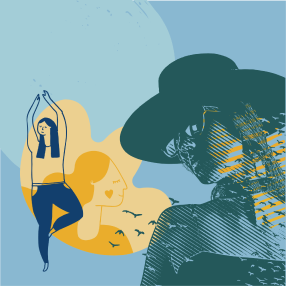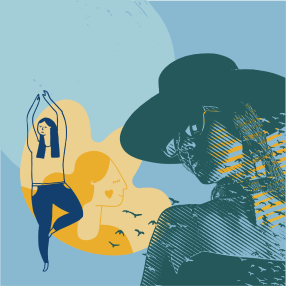Burberry is in the trenches right now. Britain’s biggest luxury fashion brand, home of the iconic beige mac and that check print, recently issued its third profit warning of the year so far. Retail sales have dropped by 21 per cent in the first fiscal quarter, and reports suggest that several hundred jobs at the company are at risk, too. And the bad news keeps on coming. On Monday, Burberry announced the departure of its CEO, Jonathan Akeroyd, who only joined the business back in 2022, and suspended dividend payments. Soon after, shares slumped to their lowest level since 2010. Can Britain’s most celebrated fashion export weather this storm?
Akeroyd’s replacement Joshua Schulman, who arrives from the all-American label Coach, will certainly have his work cut out in the months ahead. It’s all a far cry from the 2010s – when Burberry was undisputedly the biggest draw of London Fashion Week, beloved by the likes of Kate Moss, Sienna Miller and Cara Delevingne, all of whom appeared in ad campaigns for the label. But you could also see it as simply the latest twist in the tale of a divided brand with a chequered past, a story that encompasses high fashion and cheap copycats, catwalks and football terraces.
Burberry’s heritage dates back to the Victorian era, when draper’s apprentice Thomas Burberry opened his first clothing shop in 1856. His great innovation was to waterproof his yarn with lanolin, creating a new, weather-resistant fabric called gabardine, which resulted in coats that were lighter weight than a traditional mackintosh (which was sweaty, smelly and cumbersome). Gabardine was adopted by polar explorers like Sir Ernest Shackleton. When the First World War broke out, Burberry was commissioned to come up with a coat that could be worn by officers on the battlefield. The resulting “trench coat” wasn’t just adopted by soldiers. It also proved popular with civilians – so popular, indeed, that by the Thirties, the company had a dedicated van that would travel around London offering same-day deliveries.
The iconic beige, red, black and white check print, meanwhile, was a relative late-comer. It was first introduced into the coats’ linings in the Twenties, but didn’t really come to prominence until a few decades later, when staff at Burberry’s Parisian boutique decided to wrap accessories in the fabric before a visit from the British ambassador in the Sixties. By this point, the brand had a reputation as a solid, quality British label: not the most exciting proposition, perhaps, but dependable all the same.
It had a brief resurgence of cool when it was worn by Britpop stars, but by the late Nineties, Burberry was floundering. The brand had sold licences that allowed other companies to use the famous check on other products, meaning that it cropped up on an array of products (beige tartan dog coats, for example) that didn’t exactly sit well with Burberry’s upmarket feel. Plus, copycat products and fakes were becoming a big problem.
Just a few years later, the check print had become synonymous with rowdy football fans and over-dressed Wags, a visual shorthand for what appalled media commentators called “chav culture”. A 2002 photo showing the EastEnders actor Danniella Westbrook wearing a Burberry check outfit, carrying a Burberry handbag and pushing her Burberry-clad daughter in a Burberry pushchair, was branded “chavtastic” by a Sun headline. News stories abounded about pubs and bars imposing blanket bans on anyone dressed in the notorious tartan: it was irrevocably associated not just with a type of nouveau riche flashiness, but with hooliganism and violence. None of this was particularly great PR for a label that was supposed to be all about low-key, classic style.
Under Bailey, the brand felt both traditional and forward-thinking, romantic with an edge
Against this backdrop, then-CEO Rose Marie Bravo had hired Christopher Bailey as the brand’s design director in 2000. Bailey had just spent five years working with Tom Ford at Gucci, and so he’d had a ringside seat as Ford had transformed that brand from fusty purveyor of bags and scarves to the most talked-about name in fashion. One of his first moves was to cut back on the checks (in 2004, the company revealed they were stopping making their checked baseball caps altogether) and begin charting a new direction.
Under Bailey, the brand felt both traditional and forward-thinking, romantic with an edge. The trench coat – whether it was the classic beige style or reworked versions in bold metallics, lace or painterly prints – became a signifier of cool, thanks to ad campaigns populated by various bright young Brits such as Emma Watson, Felicity Jones and Eddie Redmayne. It was the hottest ticket in fashion week, its shows truly a spectacle, boasting musical performances (that often kickstarted said performer’s career, as we saw with James Bay and Tom Odell) and the best front row in London. Bravo’s successor Angela Ahrendts was also a particularly shrewd businesswoman, buying back many of the aforementioned licences to stop the brand being diluted, and doubling down on tech and social media. In the period between 2007 and 2013, annual sales more than doubled to £1.9bn.
Things became a little rocky, though, when Ahrendts was poached by Apple in 2014. Bailey became chief creative officer and president at the brand, but investors weren’t always happy about this double role. Sales slowed down; some shareholders also agitated about his high salary. In 2018, he left the brand, with the Italian designer Riccardo Tisci taking over. He brought a glossy, streetwear-inflected sensibility and seemed to court a younger crowd, hiring American models of the moment like Kendall Jenner and the Hadid sisters to walk in his shows. But he never really set critics and customers’ imaginations alight.
After Tisci’s exit in 2022, the company hired Daniel Lee, a British designer who had recently made his name transforming the fortunes of Italian label Bottega Veneta. Under Lee, Bottega went from a solid heritage brand to a major fashion player beloved by Rihanna and A$AP Rocky. He seemed well placed to kickstart a Burberry revival – plus, it surely didn’t hurt that he hailed from Yorkshire, like Bailey, and talked the talk about wanting to restore a sense of Britishness to the brand. He delivered attention-grabbing front rows and catwalk line-ups; last year, Britpop descendents Iris Law and Lennon Gallagher walked the runway, in a blatant grab at some residual “Cool Britannia” edge. There was plenty of chat about Burberry going “back to its roots”. And yet, despite all of this, the reaction has been muted.
Put simply, no one is buzzing about Burberry like they did in the Bailey years. But even though it no longer feels like an “it” brand, the company has still been pursuing what’s known as an “elevation strategy”, an attempt to become an even more premium brand, leveling up from a successful British fashion house to a global luxury force on the level of the likes of Gucci. As part of this move, the brand has reportedly cranked up prices on its accessories – according to one estimate, a recent accessory collection was priced 58 per cent higher than previous collections – and cut back on “entry level” products, at a time when aspirational shoppers are having to scale back their spending due to the cost of living crisis. Drastically increasing prices, with the aim of appearing higher end, seems to have backfired and turned shoppers off. The fashion market is a tricky one right now, and only timeless accessories like the Hermes Birkin are bucking the trend: Burberry arguably doesn’t have the same luxe cachet (its hero piece has always been a coat, not a handbag).
It seems like the brand might have overreached, aiming for the top of the industry while neglecting more aspirational customers. Burberry’s new CEO choice is certainly an interesting one: Joshua Schulman’s retail CV is filled with accessible labels that have always tended to sit in the middle of the luxury market. Perhaps it’s a clue that the company might be about to opt for a more mainstream approach. Top of his to-do list, surely, will be sorting out Burberry’s identity crisis – otherwise it might be checkmate.
Source: independent.co.uk


